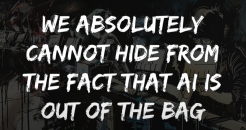 How AI is revolutionising education
How AI is revolutionising education
From a talk at Digital Leaders week
In his Digital Leaders Week presentation, Ben Whitaker, founder of Edufuturists, delves into the concept of "positive disruption," specifically how AI is transforming education. Ben's own background is as an assistant principal and also the host of the EduFuturist podcast, where he interviews global experts on the future of education.
AI has the potential to revolutionize various fields in multiple sectors such as education, healthcare, marketing, public services, and entertainment. From an educational perspective, AI offers significant potential to alleviate the workload of overburdened teachers, addressing challenges like teacher recruitment. Ben discusses the importance of being adaptable to change, both for educators and students, in order to fully leverage the benefits of AI.
Ben demonstrates various emerging tools; OpenAI's tool, Sora, which can generate video from text prompts, Google's experimental Notebook LM, powered by Gemini 1.5 Pro AI, which aims to support students and teachers in research and writing tasks. For those who learn best through auditory means, Gemini has a feature called "audio overviews." This feature enables Notebook LM to take various educational materials and convert them into an engaging audio discussion tailored for a student.
During a demonstration, the AI generated a discussion focused on Sir Isaac Newton's three laws of motion. The student could interact with the AI, asking questions and steering the conversation. For instance, when the student requested an example related to basketball, the AI seamlessly incorporated the sport into the explanation of force and motion, making the lesson both relevant and captivating for the student.
This personalized and interactive method represents a significant departure from traditional learning approaches, highlighting how AI can revolutionize education by catering to individual learning preferences and needs.
AI has already surpassed human capabilities in areas such as grade school math, speech recognition, and reading comprehension. This trend underscores the urgency for educators to integrate AI into their teaching strategies to prepare students for a future where AI plays a central role. Ignoring AI is no longer an option, especially considering its rapid advancement and potential to alleviate challenges such as teacher workload and well-being.
Ben also quotes Professor Sugata Mitra, who argues that the education system isn't broken but outdated, and no longer necessary in its current form due to the advancements in technology and AI. To address this disruption, Ben suggests applying Kathryn Danaher's formula for change, which involves three key elements:
1. Dissatisfaction with the Status Quo:
The current education system is outdated and does not meet the needs of students or educators. Issues such as lower attendance rates, high teacher turnover, and dissatisfaction among students and teachers indicate that the status quo is no longer effective.
2. Vision of What is Possible:
A new way of education should be personalized, addressing the individual needs of each student rather than a one-size-fits-all approach. The vision should include an exploratory curriculum that fosters curiosity and allows students to engage deeply with subjects they are interested in.
On-demand learning should be a key component, enabling students to learn at their own pace and on their own schedule.
Creativity should be nurtured through AI tools like MidJourney, helping students develop creative skills.
Accessibility is crucial, ensuring that all students, including those with additional needs, have equal opportunities to learn and thrive. AI tools can help create an inclusive and dignified learning environment.
3. First Concrete Steps:
Implementing the vision requires taking concrete steps to integrate AI and personalized learning approaches into the education system. Educators need to be trained and supported in using these new tools and methodologies effectively. The importance of rethinking education in light of AI and creating a system that is adaptable, innovative, and inclusive.
In developing practical steps for integrating AI in a positive and effective manner, Ben suggests using the "CRAAP test," developed by librarians at the University of California, as a critical thinking tool to evaluate AI-generated content and other information sources. The CRAAP test involves assessing:
-
Currency: How recent is the information?
-
Relevance: How important is the information for your needs?
-
Authority: What are the source's credentials?
-
Accuracy: How reliable and correct is the content?
-
Purpose: Why does this information exist?
Young people should be explicitly taught to use this test to evaluate content from AI tools, social media, and other sources. This helps them critically assess the information's validity, relevance, and potential biases.
Several concrete steps are suggested that educators can take to effectively integrate AI:
-
Playing with AI tools: Experiment with various AI tools to understand their capabilities and limitations.
-
Creating a culture of managed risk-taking: Encourage a culture where stakeholders (students, parents, teachers, etc.) can safely explore and discuss AI's implications and benefits.
-
Embedding AI in policies and procedures: Integrate AI considerations into existing policies and procedures, ensuring that AI is normalized within the educational framework.
-
Asking critical questions: Evaluate AI tools by asking questions about cost, data protection, training data, and integration with other tools.
-
Discussing ethics and biases: Engage in conversations about the ethical implications, biases, and dangers of AI tools.
-
Collaborating and networking: Work together with others to share knowledge, experiences, and best practices in AI integration.
Watch this 45 min talk here:
Retweet about this article:
From a talk at Digital Leaders week, 05/03/2025